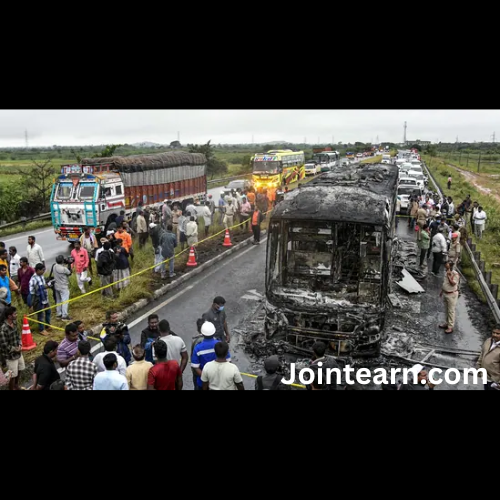
In the early hours of Friday, a private sleeper bus traveling from Hyderabad to Bengaluru met with a catastrophic accident on National Highway 44 (NH-44) near Kurnool in Andhra Pradesh, leaving 19 people charred and several others injured. Initially believed to have crashed directly into a motorbike, subsequent investigations by police and forensic experts have revealed a more complex chain of events that led to the tragic fire.
Sequence of Events
The bus, operated by V Kaveri Travels, was moving along NH-44 when it ran over a motorbike lying on the road. The two-wheeler had earlier been involved in an accident, and its rider had reportedly died on the spot. Most passengers were asleep in the bus at the time, leaving them with little or no time to evacuate once the fire broke out.
Authorities quickly rushed to the scene, but the combination of sleeping passengers, the rapid spread of flames, and the highly flammable materials inside the bus led to a massive inferno. Eyewitness accounts and CCTV footage suggest that the bus collided with the stationary bike around 2:39 am, immediately triggering a fire that engulfed the vehicle.
Role of Smartphones and Batteries
Forensic experts investigating the incident have pointed to a consignment of smartphones in the luggage compartment as a potential factor that intensified the blaze. The bus was transporting 234 brand-new mobile phones, worth an estimated ₹46 lakh, for a trader identified as Manganath, from Hyderabad to Bengaluru.
“These new mobile phones stored in the luggage cabin might have caught fire and exploded, aggravating the blaze,” said Andhra Pradesh Fire Services Director General P Venkataramana. Witnesses reported hearing popping sounds during the fire, indicating that the lithium-ion batteries of the phones may have burst under the extreme heat, feeding the flames further.
In addition to the smartphones, the bus was equipped with an air-conditioning system powered by electric batteries. The extreme heat from the initial fire caused these batteries to explode as well, contributing to the rapid escalation of the blaze. The spilled petrol from the fallen bike added yet another combustible element, igniting almost instantly when the bus ran over it.
Conflicting Views on the Cause
While forensic experts have highlighted the potential role of mobile phone batteries in intensifying the fire, police officials have suggested that the primary cause was the combination of the bus’ batteries and the bike’s fuel tank. Kurnool Range Deputy Inspector General of Police Koya Praveen explained that the fire erupted near the main exit door, where the bus’ two 12 KV batteries were located. These batteries exploded, worsening the situation and blocking a critical evacuation point.
He also noted that the bus’ interior contained highly combustible materials, including metallic paints and synthetic furnishings, which contributed to the rapid spread of the fire. “The fuel tank of the two-wheeler was not the major cause of the fire. The key factor was the bus batteries exploding behind the main exit door,” he said, downplaying the role of the smartphones.
Human Toll and Aftermath
The Kurnool bus fire has left 19 people dead, most of them burned beyond recognition, while several others sustained injuries. Emergency services, including firefighters, paramedics, and police, rushed to the scene, rescuing those who could be evacuated. Authorities are now piecing together the exact sequence of events to understand how the combination of factors—fallen bike, electric batteries, mobile phones, and flammable interior materials—contributed to the disaster.
This tragedy has sparked widespread anger and calls for stricter regulations around the transport of electronic goods and flammable materials in public vehicles. Experts note that lithium-ion batteries, commonly used in smartphones, are highly susceptible to catching fire when subjected to heat, impact, or short-circuiting, making their transport in large numbers on passenger buses particularly risky.
Investigations Underway
Police and forensic teams continue to examine the scene, bus wreckage, and CCTV footage to determine the precise cause of the fire. Investigators are focusing on multiple elements, including the positioning of the luggage compartment, the storage of electronic goods, the bus’ battery system, and the presence of any combustible materials.
The incident also highlights the broader issue of road safety and the handling of hazardous materials on public highways. Hyderabad police commissioner VC Sajjanar had earlier condemned drunk driving in connection with the bike accident, calling reckless drivers “terrorists” on the road. The Kurnool tragedy underscores how a combination of negligence and unsafe transport practices can escalate into a mass casualty event.
Public Safety Measures and Recommendations
Following the Kurnool fire, experts have suggested several safety measures to prevent similar incidents in the future. These include:
- Stricter Guidelines for Transporting Electronics: Large consignments of lithium-ion batteries and electronic goods should be transported under regulated conditions, ideally in cargo vehicles designed to handle flammable materials safely.
- Bus Safety Enhancements: Public transport vehicles should be equipped with fire suppression systems, emergency exit access points, and clear protocols for evacuating passengers quickly.
- Road Safety Enforcement: Increased monitoring and control of vehicles, especially during nighttime travel, can prevent accidents caused by inattentive or impaired drivers.
- Public Awareness: Passengers and operators alike must be informed about the risks associated with carrying combustible materials in passenger compartments.
Conclusion
The Kurnool bus fire serves as a grim reminder of how multiple factors, each seemingly minor on its own, can combine to produce a catastrophic event. From a fallen motorbike and spilled petrol to the explosion of batteries in smartphones and the bus’ own AC system, the disaster illustrates the dangers of modern transport where electronics and flammable materials coexist.
As forensic investigations continue, authorities are expected to recommend tighter regulations and preventive measures to ensure that such a tragedy is not repeated. Meanwhile, the families of the victims continue to grieve, seeking accountability and justice for the lives lost in what has become one of the deadliest bus fires in recent memory.


Leave a Reply